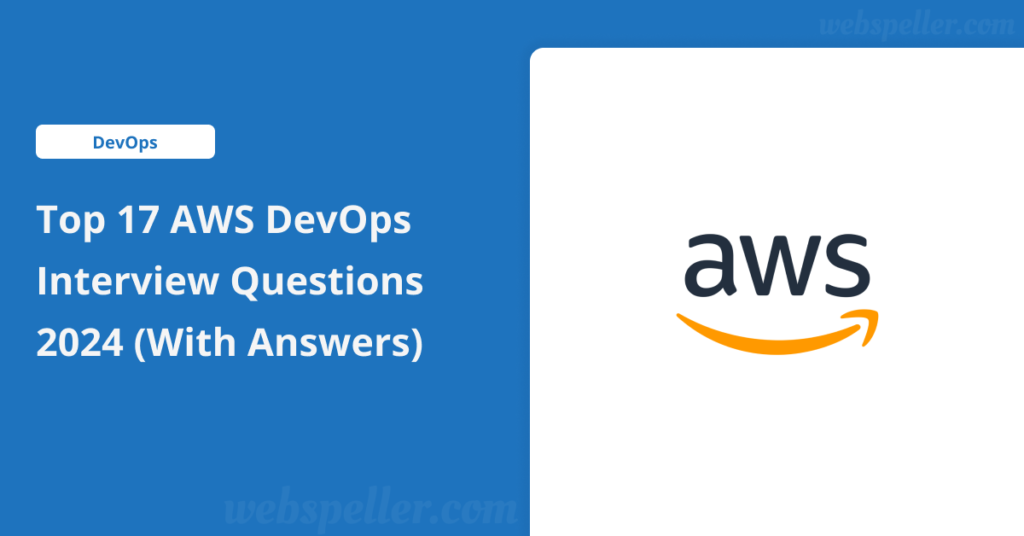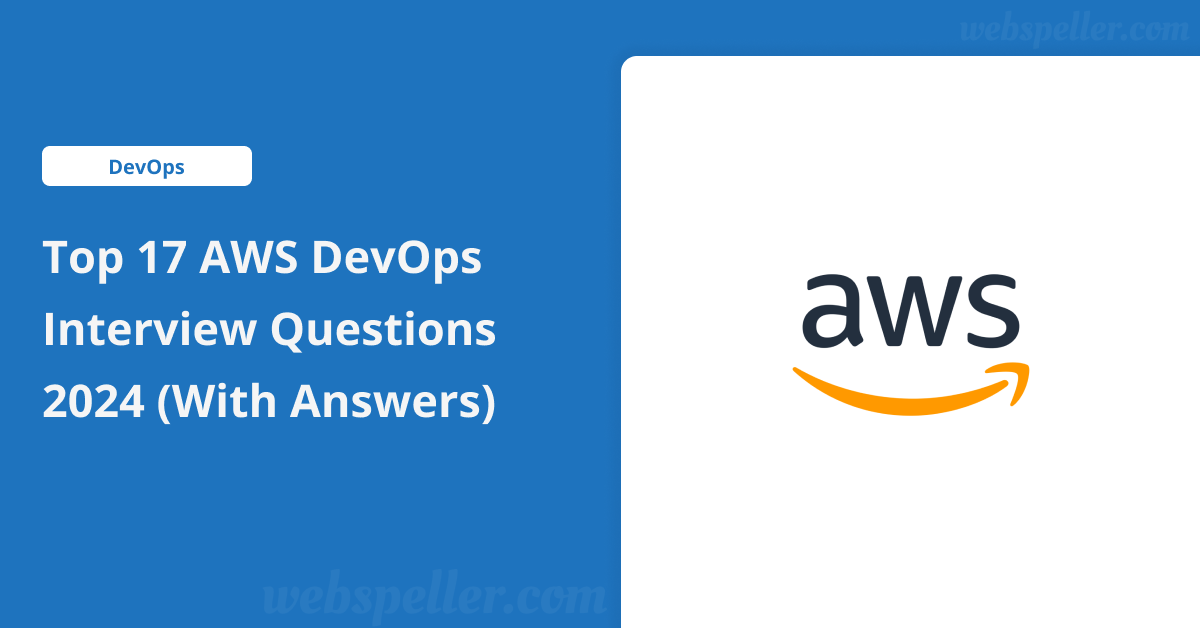
Table of Contents
Introduction
If you’re preparing for an AWS DevOps interview, you’re likely aware of the depth and complexity that comes with mastering both Amazon Web Services (AWS) and DevOps principles. Whether you’re a newcomer to the field or a seasoned professional, having a solid grasp of key AWS DevOps concepts is essential to impress your interviewer and land the job.
In this article, we’ll walk you through 17 essential AWS DevOps interview questions. From beginner-level fundamentals to advanced problem-solving scenarios, this guide is designed to give you the confidence you need to tackle your next interview.
Let’s dive in!
Why AWS for DevOps?
Before we jump into the questions, it’s crucial to understand why AWS has become the go-to platform for DevOps. AWS dominates the cloud infrastructure market with a massive 31% share as of 2024, surpassing competitors like Microsoft Azure (25%) and Google Cloud (11%).
AWS offers a wide array of services that make DevOps implementation smoother, including continuous integration and delivery (CI/CD), automated infrastructure provisioning, and robust monitoring tools. For those looking to build a career in DevOps, mastering AWS is not just an option—it’s a necessity.
Basic AWS DevOps Interview Questions
1. What is DevOps, and how does AWS support it?
DevOps is a set of practices aimed at automating and integrating software development (Dev) and IT operations (Ops). It helps teams deliver software faster and more reliably.
AWS supports DevOps with services like AWS CodePipeline for CI/CD, CloudFormation for infrastructure automation, and CloudWatch for monitoring.
2. Can you explain “Infrastructure as Code” (IaC) and how AWS implements it?
Infrastructure as Code (IaC) is the process of managing and provisioning computing resources using code. In AWS, this is done primarily with AWS CloudFormation, allowing you to define your infrastructure in a template file and deploy it automatically.
3. What is AWS CloudWatch, and how is it used in DevOps?
AWS CloudWatch is a monitoring service that collects and tracks metrics, logs, and events. In DevOps, it’s used to monitor application performance, set up alarms, and automate responses to operational changes, ensuring system health and efficiency.
4. What does “Everything as Code” mean in DevOps?
“Everything as Code” extends IaC to other areas like configuration, security, and documentation. AWS supports this with services like AWS Config for managing resource configurations, IAM for security policies, and CloudFormation for infrastructure.
Intermediate AWS DevOps Interview Questions
5. How does AWS CodePipeline enable CI/CD?
AWS CodePipeline automates the build, test, and deploy phases of your application development. Every time you update your code, it triggers your pipeline, ensuring a smooth, automated workflow from development to deployment.
6. What is AWS Systems Manager, and how is it used in DevOps?
AWS Systems Manager helps you manage AWS resources by collecting inventory, applying patches, and automating operational tasks across services. It’s often used in DevOps for configuration management, automating deployments, and ensuring system compliance.
7. What are the advantages of AWS CodeCommit over other version control systems?
AWS CodeCommit is a managed Git service that integrates with other AWS tools. Its advantages include unlimited repositories, scalability, seamless AWS integration, and encrypted storage for enhanced security.
8. How do you use AWS CloudTrail in a DevOps environment?
AWS CloudTrail helps track API calls and user activity across your AWS environment. In DevOps, it’s crucial for auditing changes, troubleshooting issues, and ensuring compliance with security policies.
Advanced AWS DevOps Interview Questions
9. How would you implement a blue/green deployment strategy on AWS?
To implement a blue/green deployment, use services like AWS Elastic Beanstalk or ECS. You create two identical environments (blue and green), deploy new updates to green, and then shift traffic using Route 53 or a Load Balancer after confirming the new version works as expected.
10. How can AWS Config be used for compliance and governance?
AWS Config continuously monitors your AWS resources, assessing whether they comply with internal and external regulations. It allows you to set up rules for compliance and can automatically remediate non-compliant resources.
11. How do you implement a canary deployment with AWS services?
Using AWS CodeDeploy, you can configure canary deployments to shift a small portion of traffic to the new version of your application. This allows you to test the new version in production before fully rolling it out.
AWS DevOps Engineer Interview Questions
12. How would you design a highly available and scalable application architecture on AWS?
Key components include using multiple Availability Zones, Auto Scaling, and Elastic Load Balancers to distribute traffic. Implement a caching layer with ElastiCache, use RDS Multi-AZ for database availability, and CloudFront for content delivery.
13. How do you use AWS CloudFormation to implement IaC?
AWS CloudFormation allows you to define and deploy your infrastructure through code, enabling you to manage your resources like servers, databases, and load balancers from a single template file.
14. What’s your approach to disaster recovery for a multi-tier application on AWS?
A robust disaster recovery plan involves Multi-AZ deployments, cross-region replication for databases, S3 cross-region replication, automated backups using AWS Backup, and health checks with Route 53 for DNS failover.
Behavioral and Situational Questions
15. Describe a time when you had to troubleshoot a complex issue in production.
When tackling production issues, it’s important to gather logs and metrics, identify patterns, and work methodically to pinpoint the root cause. Once identified, implement the fix, document the issue, and communicate with stakeholders throughout.
16. How do you balance rapid deployments with system stability?
Using strategies like canary deployments and feature flags allows you to deploy features incrementally. Monitoring with CloudWatch and having a solid rollback plan ensures you maintain stability during rapid releases.
17. How do you mentor junior team members in DevOps?
Start with foundational principles, provide hands-on experiences, pair program, and offer continuous feedback. Encouraging certifications and fostering a collaborative learning environment helps junior members grow.
Conclusion
Preparing for an AWS DevOps interview can be a daunting task, but with the right preparation, you can confidently showcase your skills. This guide covers everything from basic AWS DevOps interview questions to advanced problem-solving scenarios, equipping you with the knowledge to excel in your interview.
Remember, DevOps isn’t just about knowing the tools it’s about adopting a mindset of continuous improvement and collaboration. With the growing importance of AWS in DevOps, mastering these concepts can pave the way for a successful career in the cloud.


